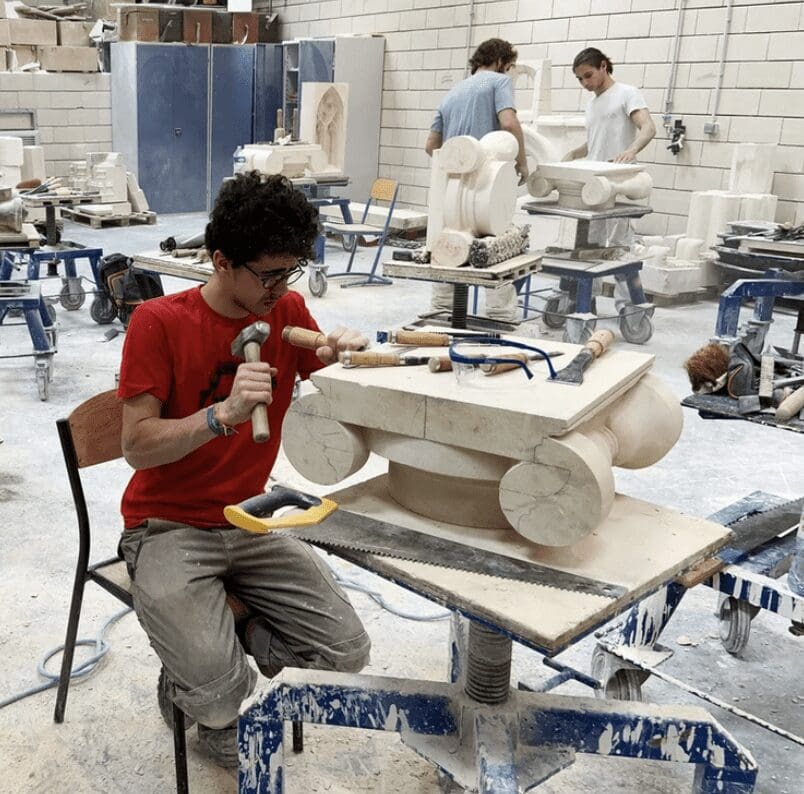Search Posts
Recent Posts
- Rhode Island Weather for June 1, 2025 – Jack Donnelly June 1, 2025
- Victory is ours: Victory gardens are blossoming again – Chuck Norris June 1, 2025
- Ask Chef Walter: The problem with “The Best” – Chef Walter Potenza June 1, 2025
- Gimme’ Shelter: Kava is waiting at the Providence Animal Control Center June 1, 2025
- Rhode Island Weather for May 31, 2025 – Jack Donnelly May 31, 2025
Categories
Subscribe!
Thanks for subscribing! Please check your email for further instructions.

Retooling esoteric design education to rebuild sustainable, beautiful cities – David Brussat
by David Brussat, Architecture Here and There, contributing writer
Photo: Student at Hector Guimard high school learn stone carving to help restore Notre-Dame. (NPR)
National Public Radio reported three years ago that the need for stone carvers to help restore the Cathedral of Notre-Dame, in Paris, following its fire in 2019, has caused schools teaching that craft to mushroom in France. These young people are being taught the same skills required to build the cathedral 900 years ago.
Good. But three years out, the NPR article by Eleanor Beardsley does little to help readers imagine how this can help architecture free itself from its century-long criminal enchantment with ugliness – or to help slow climate change, and, if you please, strike a blow against sexism in the crafts (if such a crime exists).
NPR quotes a male instructor, Luc Leblond, at Hector Guimard high school in the Paris suburbs about three miles from the cathedral:
There’s no reason this should be a masculine profession. Men have more physical force, but as a professor, I see the women have a sharpened sensitivity for the more detailed work. So it’s complementary.
Is noticing that distinction sexist? Who cares!
A female student adds: “In the beginning, it was my own parents who were surprised when I left my architecture studies to do this,” says Marjorie Lebegue. “But most everyone who finds out I’m studying to be a stone carver says, ‘Wow, what a beautiful profession.’ ” Student François Menut adds:
I’ve always been passionate about drawing and art history, but I also wanted a job that was physical. With stone carving, we give life to an edifice and perpetuate history. We’re also creating a link with the past and transmitting values that are important to conserve in society.
It is interesting that more women are chiseling away at column bases and capitals. That will make the craft more interesting to men. But much more fascinating is the idea that a swiftly growing number of stone carvers, wood carvers, masons, sculptors, ornamental craftsmen (and women) in wood and metal, etc., could push the climate agenda in a more positive direction.
Alas, few if any articles can be found on this possibility, at least I have not located any, perhaps because the idea might have been raised for the first time right here, today, on this blog. (Okay, well, probably not.)
Young people graduating from high school and college face an uncertain future as they enter the work force. Many find that their degrees have no value in the world of real work (and they know who they are). More grads should consider stoneworking and other crafts mentioned above. Maybe that would be a pathway to greater fulfillment for a much wider range of students. Matching graduates to careers likely to gain them satisfaction – such as “transmitting values that are important to conserve in society” – promises to grow more and more difficult over the next few years and decades.
Schools of art such as Rhode Island School of Design should gear their curricula away from current esoteric coursework and more toward teaching students how to create elegant versions of the purposely clunky artifacts toward which many art faculty seem to push their classes. Students should be taught how to design and fashion items such as door knobs, street lamp posts, kitchen and bathroom fixtures, bedposts and headboards, elevator floor button pads, finials for curtain rods, mouldings for ceilings, living-room lamp housings, furniture of all kinds, millwork for indoor walls, doors and furnishings, railings, mullions for windows, curved arms for park benches, and all of the many, many, indeed countless types of artifact that make civic and home life beautiful.
You can find beautiful ads advertising such products in Traditional Building and other publications. Journals on how to renovate your own house are found in far greater abundance on convenience-store racks than their modernist equivalents (if they even exist). That’s because in spite of decades of having the modernist bullyrag into our heads, people still like traditional stuff more, much more.
The RISD mission as enunciated in its original by-laws was to foster “[t]he instruction of artisans in drawing, painting, modeling, and designing, that they may successfully apply the principles of Art to the requirements of trade and manufacture.” Wow! What a great idea! Are they still allowed to do that?
It will not be easy: the creation of a global reservoir of talented workers in these fields requires a world of assistance – from firms specializing in contemporary classical architecture to create jobs for these young people. From local neighbors and preservationists crusading to pressure developers, modernist firms and municipal design panels that feel little call to promote the crafts. Such local movements will emerge as the public weighs in, more and more, on the need for architecture and planning that makes use of tradition to cut carbon use. To reduce human pressure on nature makes sense whatever the validity of alarmist frenzy. There must be more bottom-up efforts to plan, design and build projects that use methods available for centuries to heat and cool buildings before the “Thermostat Age.” The modern movement must be persuaded to re-examine the dodgy “gizmo green” system of securing government approvals and professional rewards under current LEED-based climate regimes.
The growing ranks of firms that use traditional methods of design, commercial outlets that sell traditional artifacts as described above to architectural firms, and the organizations that urge developers and civic leaders to use traditional design for development or for institutional projects remain small compared with firms that still bow down to the aesthetics of machinery, and the architects who staff them. National organizations and associations such as the American Institute of Architects see their mission as preserving those misguided prerogatives. They bow down as well to the multinational corporations whose bottom lines rely on shady accounting and exploitive financial schemes that force poor quality down the throats of the development (and every other) industry and its dependencies.
So what’s the point of this post? Is it cobbled together with fairy dust? Will the need for stone carvers at Notre-Dame lead to a magical revolution in how we build our cities and our world? Well, that is more likely than the prospect of retooling our nation’s carbon-based vehicular system to run on electricity made largely from fossil fuels. That is not going to happen, not by 2035, 2050 nor 2150.
The need to mine increasingly costly minerals in mindboggling amounts way beyond current availability puts that out of reach. A transition to electric vehicles cannot be humanly (let alone humanely) accomplished. But as this depressing realization dawns on our interlocking establishments over the next decade or so, pressure will grow exponentially to do something anyway. Perhaps retooling the design and planning professions to build cities more sustainably (and beautifully) is one possibility. The job of transitioning from modernism to tradition in architecture is, conceptually at least, much easier to accomplish.
Let the stone carvers lead the way.
___
To read other articles by David Brussat: https://rinewstoday.com/david-brussat-contributing-writer/

My freelance writing and editing on architecture and others addresses issues of design and culture locally and globally. I am a member of the board of the New England chapter of the Institute of Classical Architecture & Art, which bestowed an Arthur Ross Award on me in 2002. I work from Providence, R.I., where I live with my wife Victoria, my son Billy and our cat Gato. If you would like to employ my writing and editing to improve your work, please email me at my consultancy, dbrussat@gmail.com, or call (401) 351-0451
